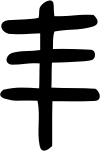
Ugaritic "ain"
Have you ever wondered why the English alphabet is ordered “A, B, C…”? Who decided that A should be first, then B, instead of e.g. S and then D? Well, we don’t know who came up with that ordering, but we know it wasn’t any later than Ugaritic cuneiform, which dates from around 1400 BC.
There might have been earlier orderings of the alphabet that we just don’t know about (because the order was transmitted orally or the written version was lost), but it seems likely that the Ugarits devised the ordering: two slightly different orderings have been found in Ugaritic cuneiform which seems unlikely if they inherited it from some other writing system. Both of those orderings have persisted: the “West Semitic ordering” made it into Hebrew, Phoenician, Greek, Latin, and thus to most of the modern alphabetic world. The “South Semitic ordering” was used by South Arabian, which lead to Ge’ez, the language of Ethiopia. When languages have added letters (e.g. the Å of Swedish), different languages have inserted them into different places, but the order of the core letters has remained amazingly constant over millennia.
It is surprising that the ordering has persisted for ~3400 years, but I guess it is one of those things where there was no advantage to changing it, and a slight disadvantage to changing it (because you had to make some effort to changing it, and a bigger effort to retraining anyone who had learned the old way).
Unusually among abjads, Ugaritic had rudimentary vowels. There were three different signs for glottal stop, depending on whether an a, i, or u was pronounced after the glottal stop. If you believe that glottal stops are consonants, then these marks were syllables and not vowels, but it still shows that people were starting to think about vowels.
Like Byblos script and Linear B Ugaritic used a vertical mark as a word separator, but due to the writing implements, it was a wedge instead of a bar.
Links: Wikipedia, Ancient Scripts, Omniglot
REVISED: Added vowels section; reworded the word separator section.











